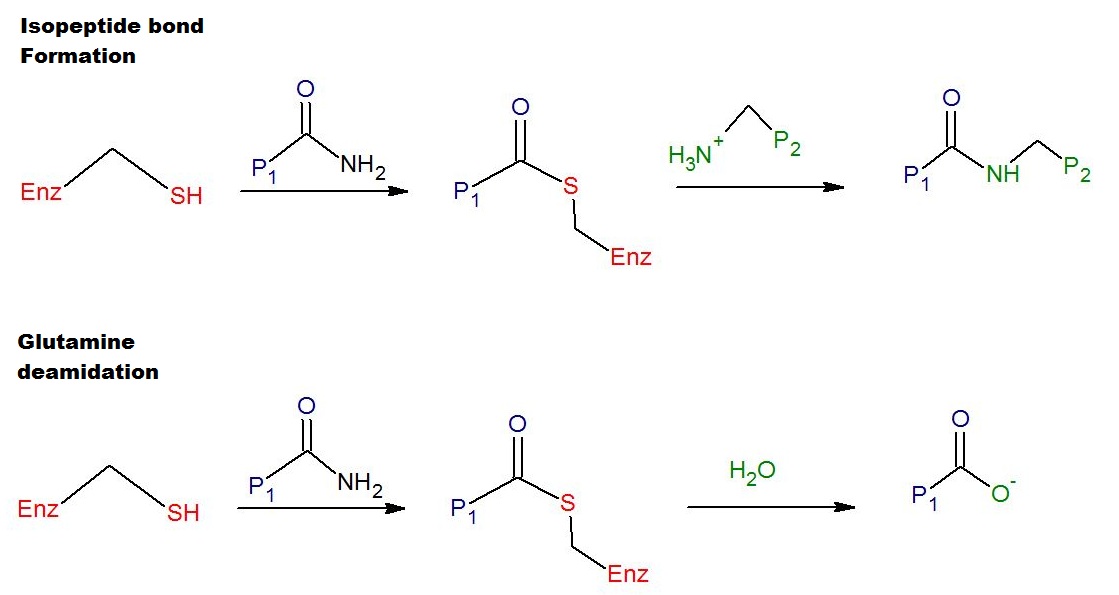|
TGM5
TGM5 is a transglutaminase enzyme Enzymes () are proteins that act as biological catalysts by accelerating chemical reactions. The molecules upon which enzymes may act are called substrate (chemistry), substrates, and the enzyme converts the substrates into different molecule .... TGM5 encodes one member of the multigene transglutaminase family. Transglutaminases (TGs) are involved in protein cross-linking by catalyzing the formation of gamma-glutamyl-lysine isodipeptide bonds between adjacent polypeptides (Candi et al. 2005; Eckert et al. 2005). This process is particularly important in the terminal differentiation of the epidermis, where TGs heavily cross-link keratins and a range of differentiation-specific structural proteins, such as involucrin, loricrin, filaggrin, and small proline-rich proteins, in the formation of the cornified cell envelope in the biogenesis of the stratum corneum, the outermost, “dead” layer of the epidermis (Kalinin et al. 2002). This continuo ... [...More Info...] [...Related Items...] OR: [Wikipedia] [Google] [Baidu] |
Transglutaminase
Transglutaminases are enzymes that in nature primarily catalyze the formation of an isopeptide bond between γ-carboxamide groups ( -(C=O)NH2 ) of glutamine residue side chains and the ε-amino groups ( -NH2 ) of lysine residue side chains with subsequent release of ammonia ( NH3 ). Lysine and glutamine residues must be bound to a peptide or a protein so that this cross-linking (between separate molecules) or intramolecular (within the same molecule) reaction can happen. Bonds formed by transglutaminase exhibit high resistance to proteolytic degradation (proteolysis). The reaction is : Gln-(C=O)NH2 + NH2-Lys → Gln-(C=O)NH-Lys + NH3 Transglutaminases can also join a primary amine ( RNH2 ) to the side chain carboxyamide group of a protein/peptide bound glutamine residue thus forming an isopeptide bond :Gln-(C=O)NH2 + RNH2 → Gln-(C=O)NHR + NH3 These enzymes can also deamidate glutamine residues to glutamic acid residues in the presence of water :G ... [...More Info...] [...Related Items...] OR: [Wikipedia] [Google] [Baidu] |
Enzyme
Enzymes () are proteins that act as biological catalysts by accelerating chemical reactions. The molecules upon which enzymes may act are called substrate (chemistry), substrates, and the enzyme converts the substrates into different molecules known as product (chemistry), products. Almost all metabolism, metabolic processes in the cell (biology), cell need enzyme catalysis in order to occur at rates fast enough to sustain life. Metabolic pathways depend upon enzymes to catalyze individual steps. The study of enzymes is called ''enzymology'' and the field of pseudoenzyme, pseudoenzyme analysis recognizes that during evolution, some enzymes have lost the ability to carry out biological catalysis, which is often reflected in their amino acid sequences and unusual 'pseudocatalytic' properties. Enzymes are known to catalyze more than 5,000 biochemical reaction types. Other biocatalysts are Ribozyme, catalytic RNA molecules, called ribozymes. Enzymes' Chemical specificity, specific ... [...More Info...] [...Related Items...] OR: [Wikipedia] [Google] [Baidu] |

